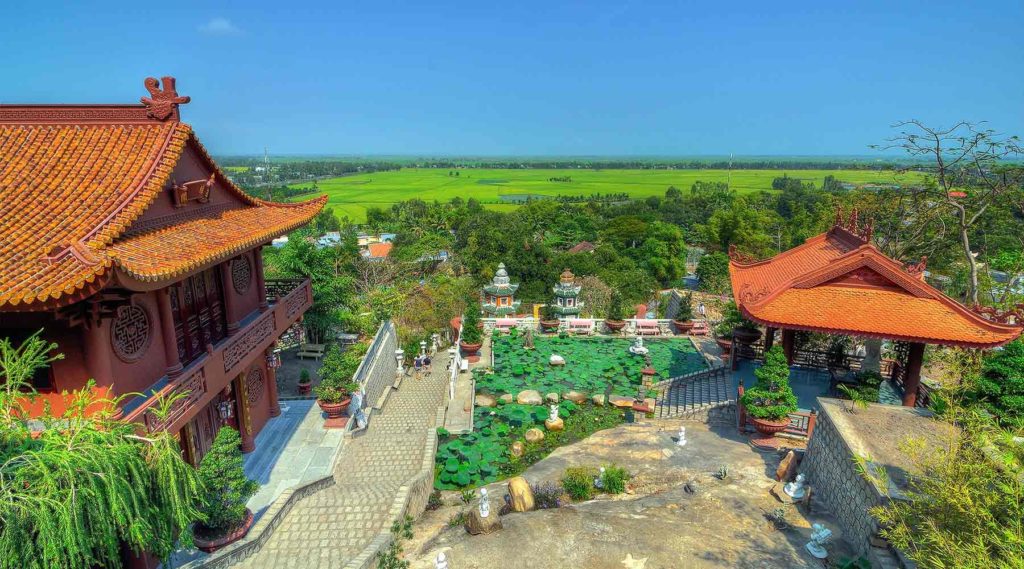What is Sam Mountain?
Sam Mountain is a 230-meter hill located about 6 kilometers southwest of Chau Doc in An Giang Province, right by the Cambodian border. It’s the highest point in the Mekong Delta, which makes it stand out in a region that is otherwise completely flat.
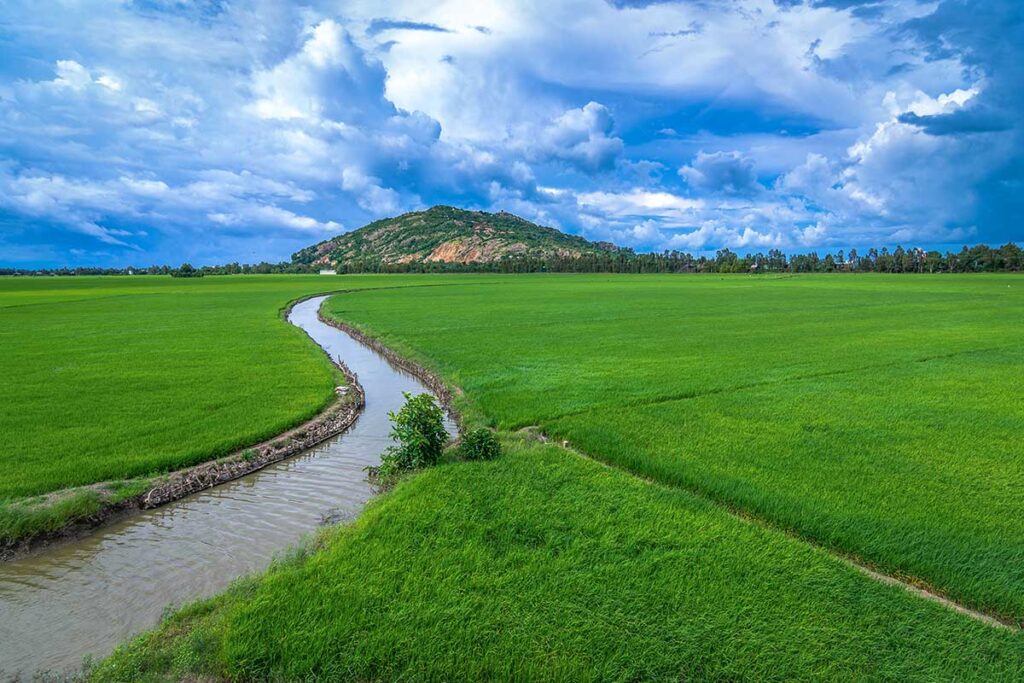
For Vietnamese pilgrims, this mountain is deeply spiritual. Dozens of pagodas and shrines sit on its slopes and at its base, with the Ba Chua Xu Temple being the most important site. Each year, the Ba Chua Xu Festival draws thousands of worshippers, making it one of southern Vietnam’s biggest religious gatherings.
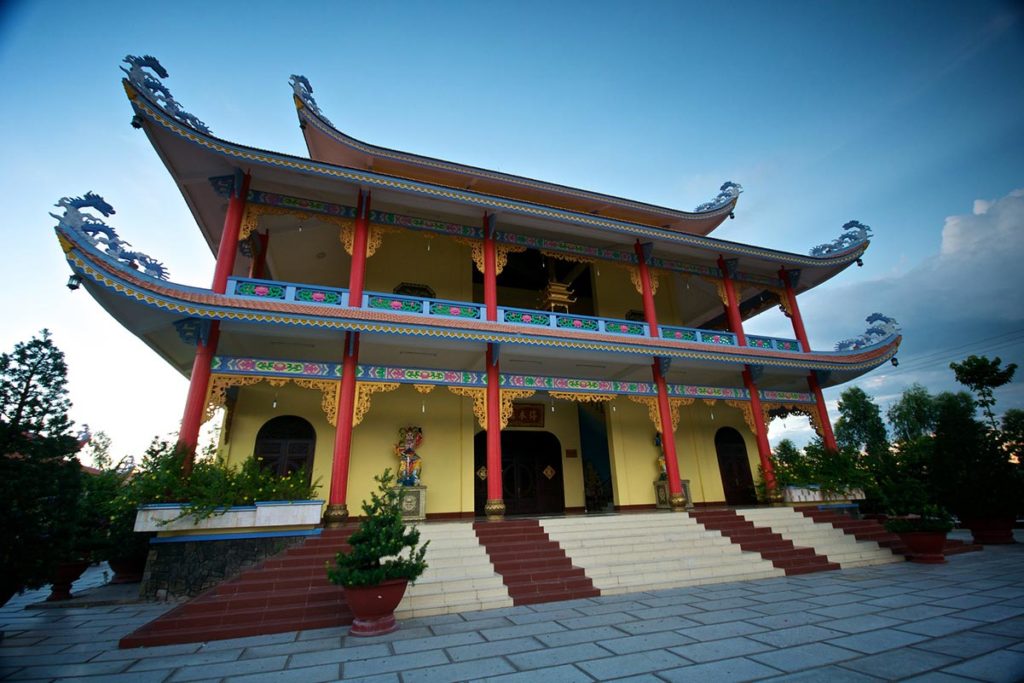
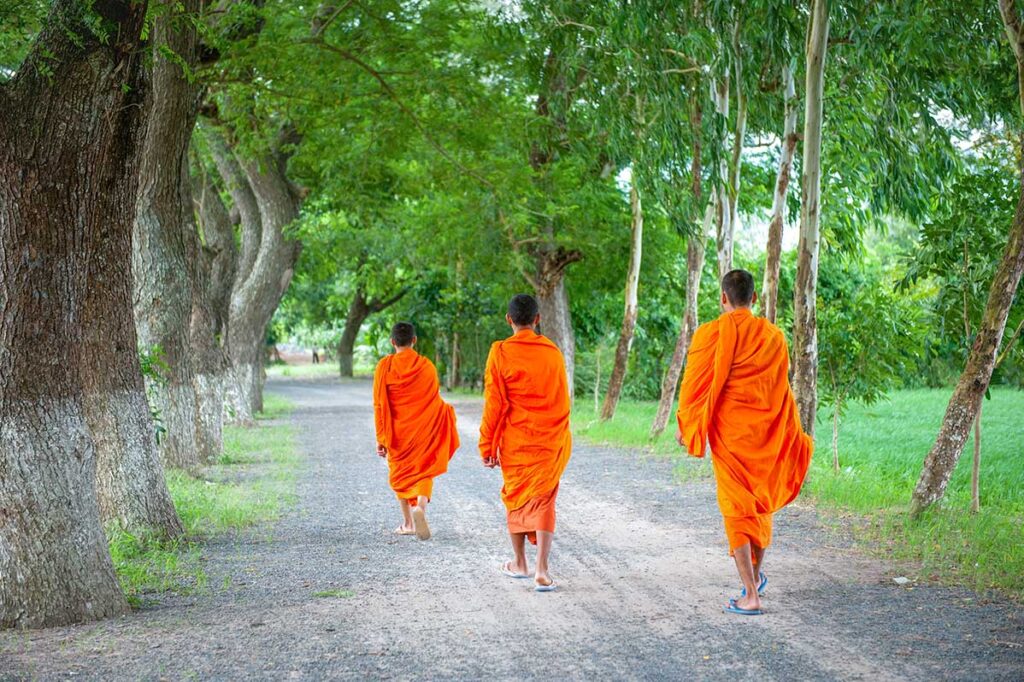
For travelers, Sam Mountain is a mix of religion, folklore, and scenery. It’s not a dramatic mountain compared to those in northern Vietnam, but the views across endless rice fields—on clear days reaching into Cambodia—make it unique in the delta.
Highlights of visiting Sam Mountain
Sam Mountain isn’t a single site but a collection of temples, shrines, and viewpoints scattered from the base to the summit. The most important and busiest temples are found at the foot of the mountain, while the slopes hold smaller pagodas and peaceful stops that are easy to miss if you rush to the top. Whether you walk, ride a motorbike, or take the cable car, you’ll notice that the experience changes depending on the route — from crowded pilgrimage sites at the bottom to quiet corners with open views higher up.
1. Tay An Pagoda (Base)
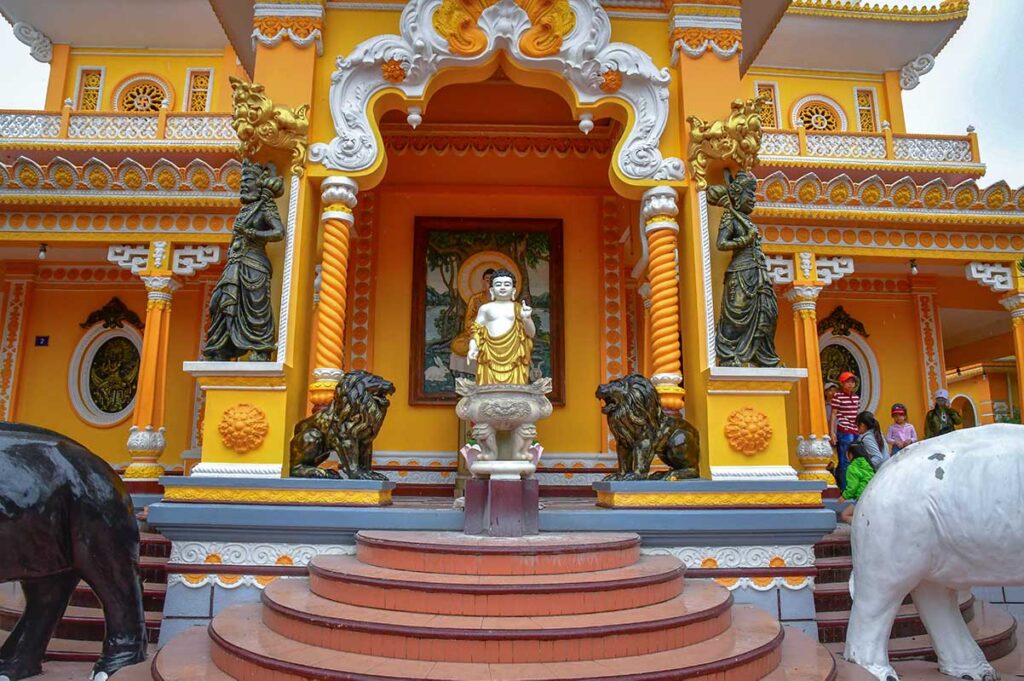
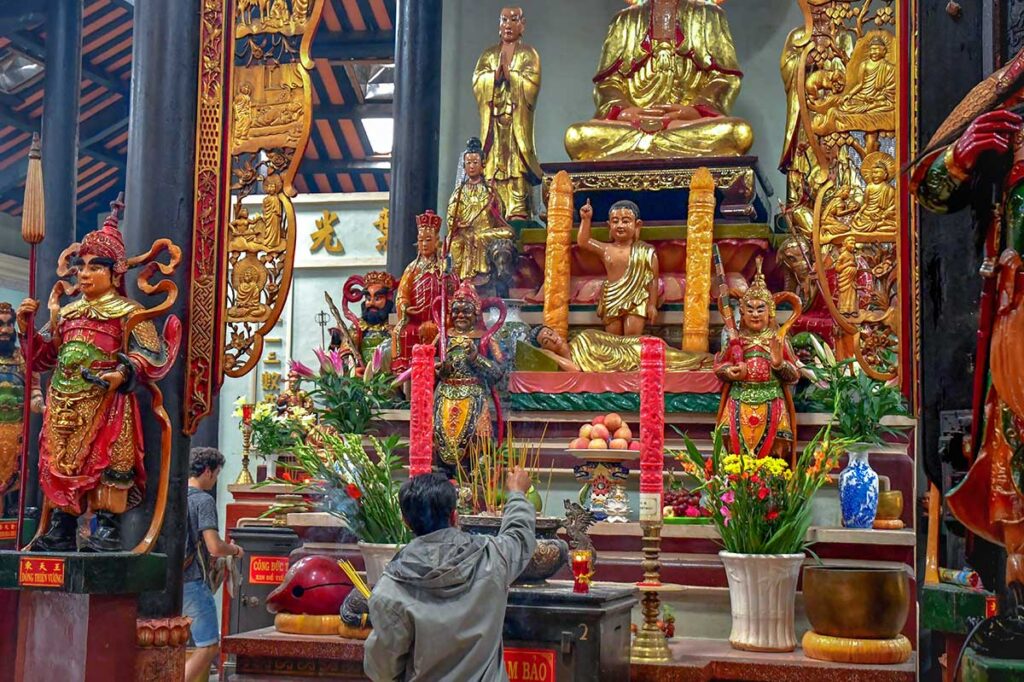
Built in 1847 and later restored, Tay An Pagoda mixes Vietnamese, Indian, Cham, and Chinese styles in a colorful way. Two elephant statues — one black, one white — stand at the entrance, making it instantly recognizable. Inside, the halls are packed with hundreds of wooden figures, ranging from serene Buddhas to fierce-looking generals. For many visitors it feels fascinating, though also a little chaotic compared to the calmer pagodas elsewhere in Vietnam.
2. Ba Chua Xu Temple (Base)
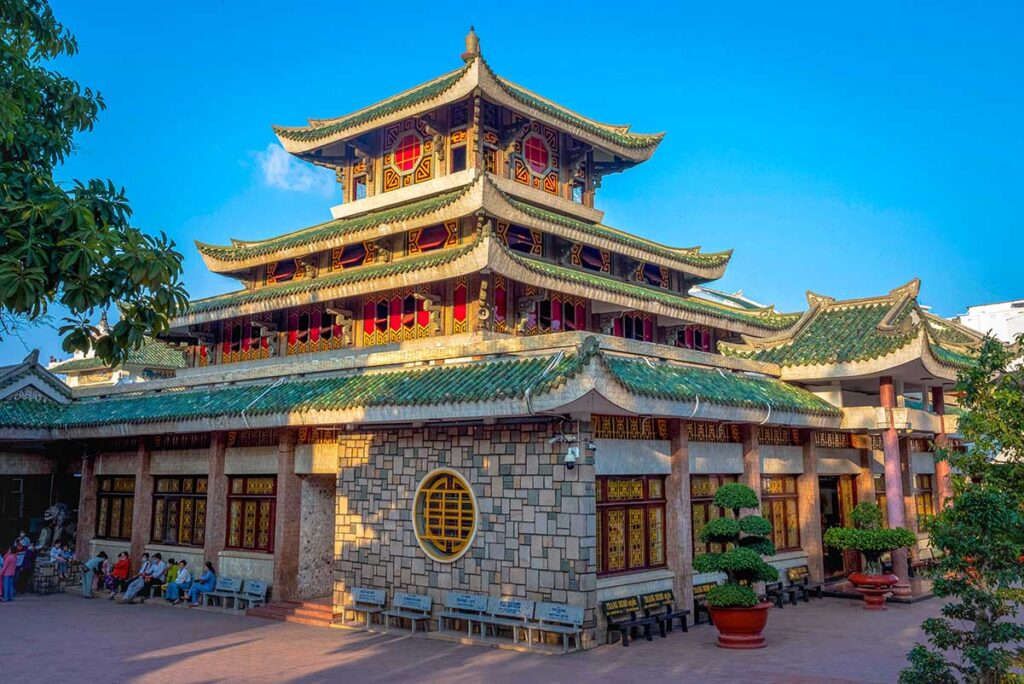
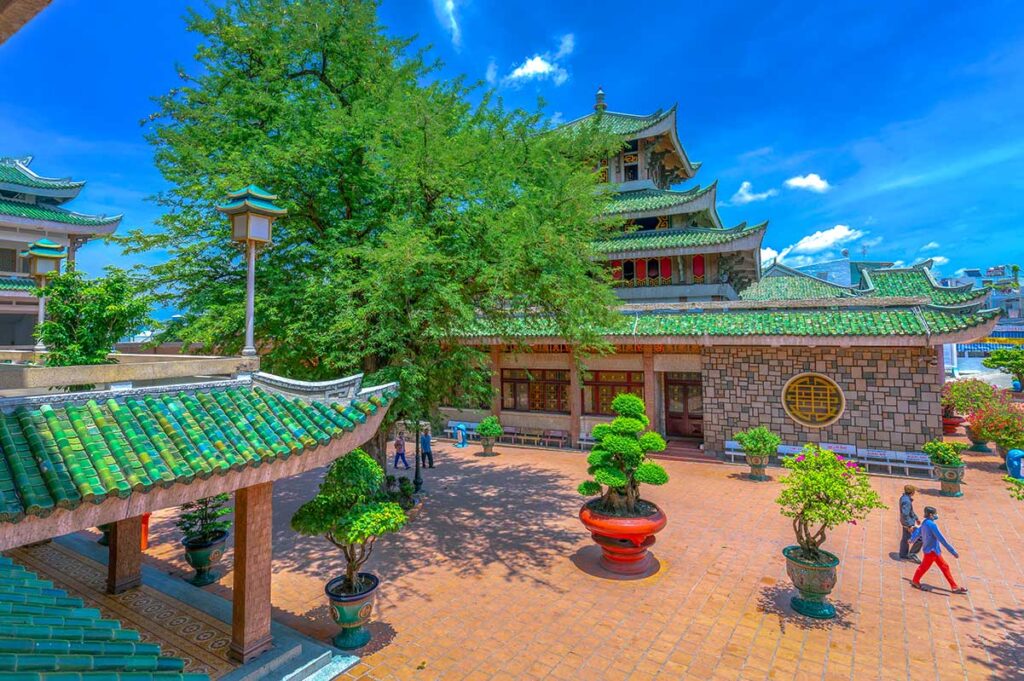
Directly opposite Tay An Pagoda is Ba Chua Xu Temple (also called Lady Temple at Sam Mountain), the most important pilgrimage site on the mountain. It houses Vietnam’s oldest sandstone statue, believed to have protective powers, and is considered the heart of local worship. During the Ba Chua Xu Festival (April/May), the temple overflows with worshippers, offerings, and ceremonies. Even outside festival time it’s usually busy, with an intense atmosphere that can feel overwhelming if you’re used to quiet temples.
3. Thoai Ngoc Hau Tomb (Base area)
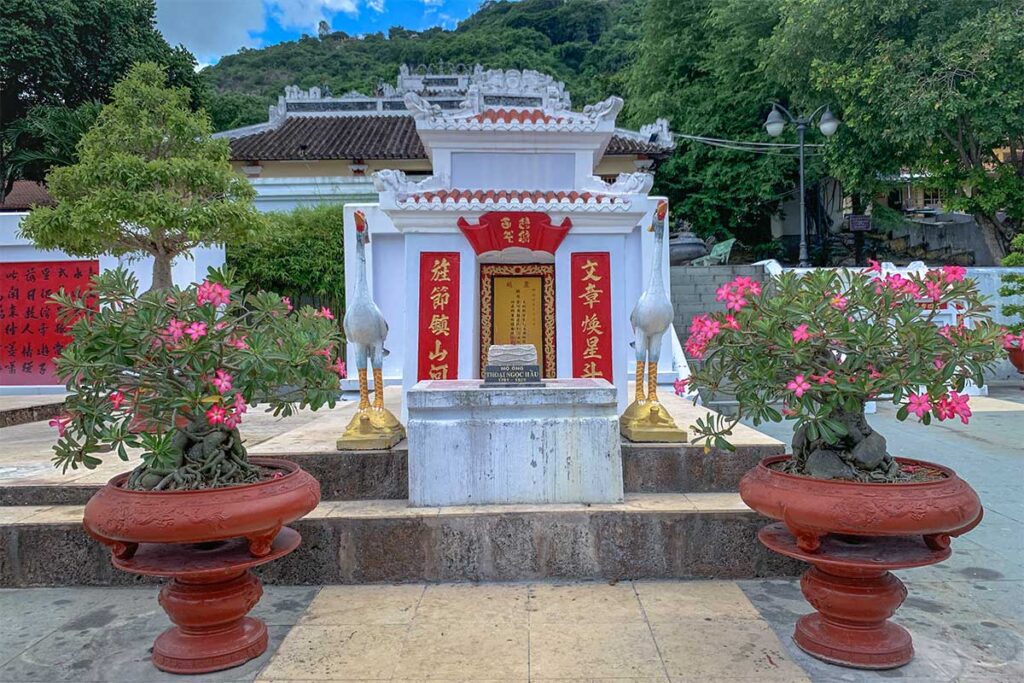
This tomb belongs to Thoai Ngoc Hau, a Nguyen Dynasty mandarin who oversaw the digging of the Vinh Te Canal and played a major role in the region’s development. Architecturally, it’s simple and not especially striking, but it carries historical weight. The site has a calm feel, making it a quick but worthwhile stop if you’re interested in Vietnam’s history.
4. The walk up
One way to reach the summit is to climb on foot, following the traditional pilgrim path. The climb is hot and tiring, especially in the middle of the day, but it gives you the chance to stop at small pagodas and shrines scattered along the way. This route feels the most spiritual and gives a better sense of why the mountain is important to locals, but it does require stamina and plenty of water.
5. Cable Car
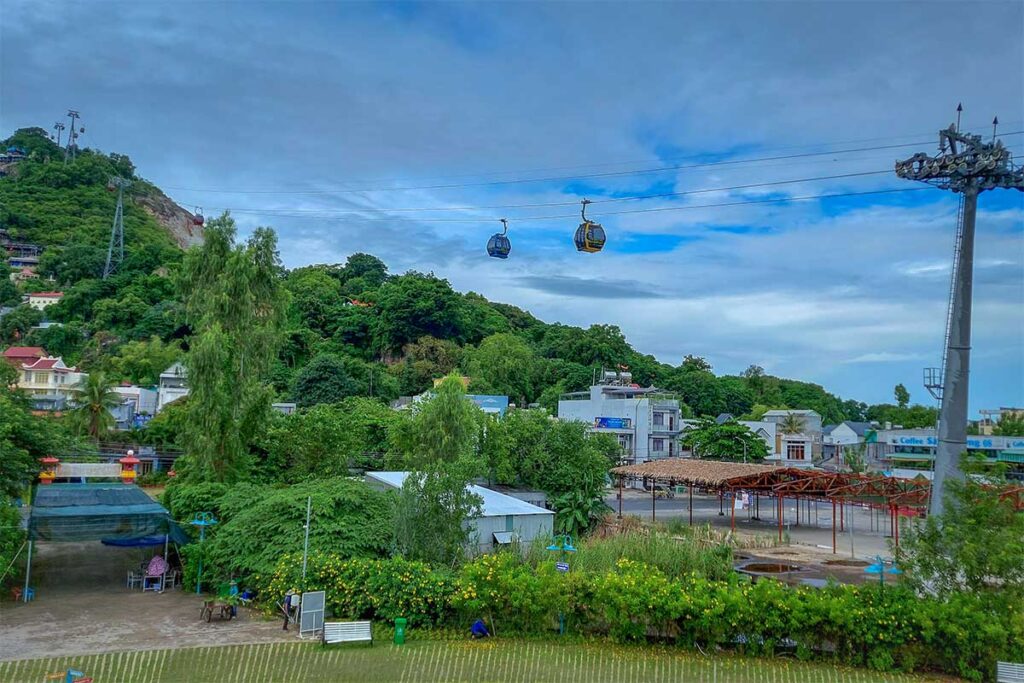
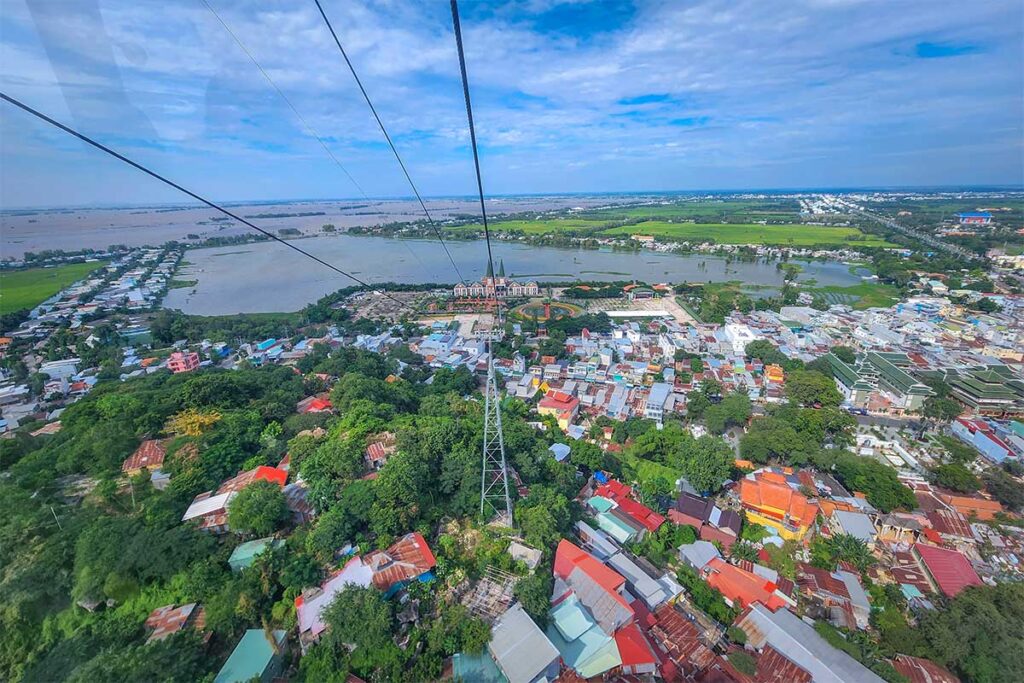
The most convenient way up is the cable car, a 900-meter ride that costs around 150,000 VND and usually includes a simple meal at the base restaurant. It’s a smooth and scenic option, offering bird’s-eye views over the rice fields, but you’ll miss most of the temples on the slope. A good compromise is to take the cable car one way and walk or ride the other, so you get both the convenience and some of the atmosphere along the mountain.
6. Hang Pagoda (Mid-slope)
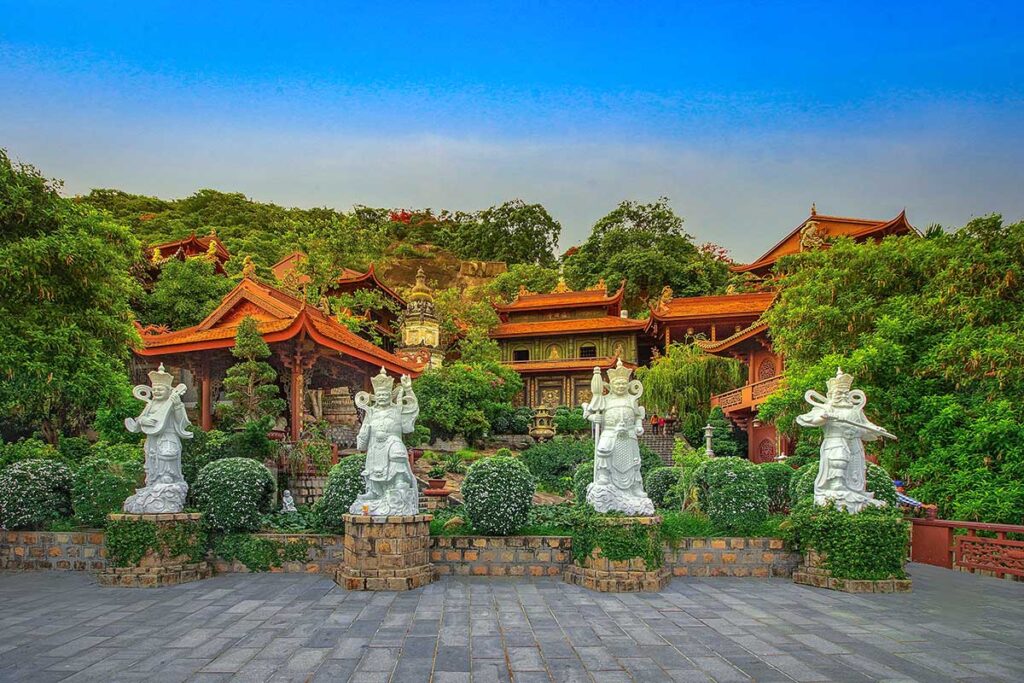
Also known as Phuoc Dien Temple, Hang Pagoda is built into the hillside and includes a small cave shrine dedicated to Quan Am, the Goddess of Mercy. The setting is peaceful, with terraces overlooking the delta. Compared to the busy temples at the base, this spot feels calmer and more rewarding, especially if you want a break from the crowds.
7. Other temples & Stops (Along the climb)
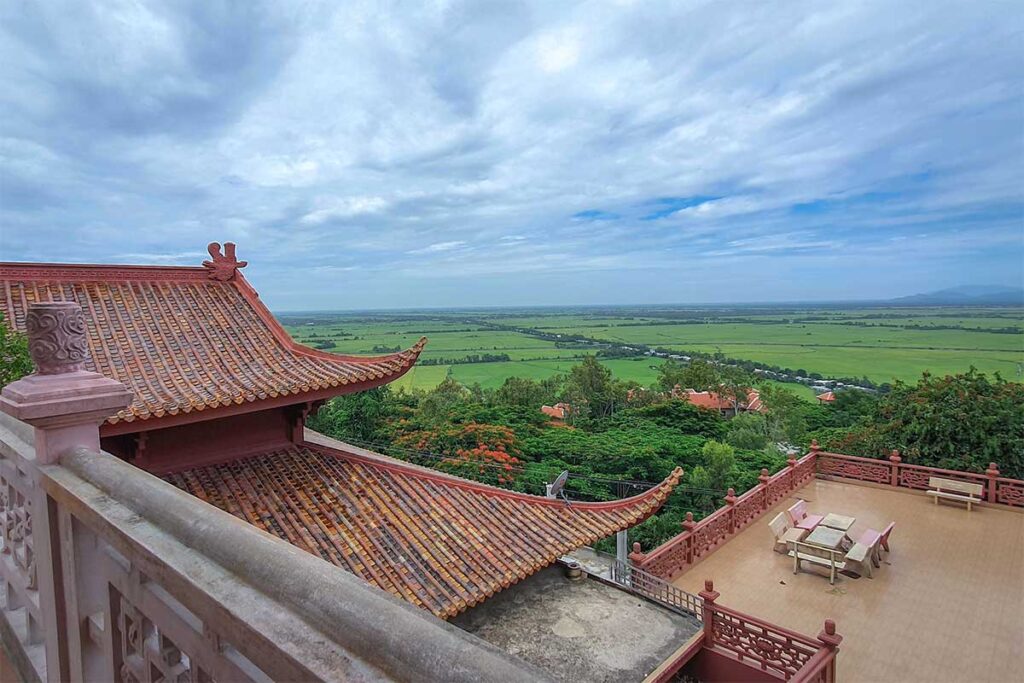
The mountain is dotted with other pagodas and resting places, including Long Son Pagoda and Tay An Co Tu Pagoda. Tao Ngo Garden and Bach Van Hill serve as shady places to pause, popular with local visitors. These stops hold more spiritual than tourist value, and while not every site is especially memorable, they add to the sense that Sam Mountain is as much a living place of worship as a sightseeing destination.
8. The summit and views
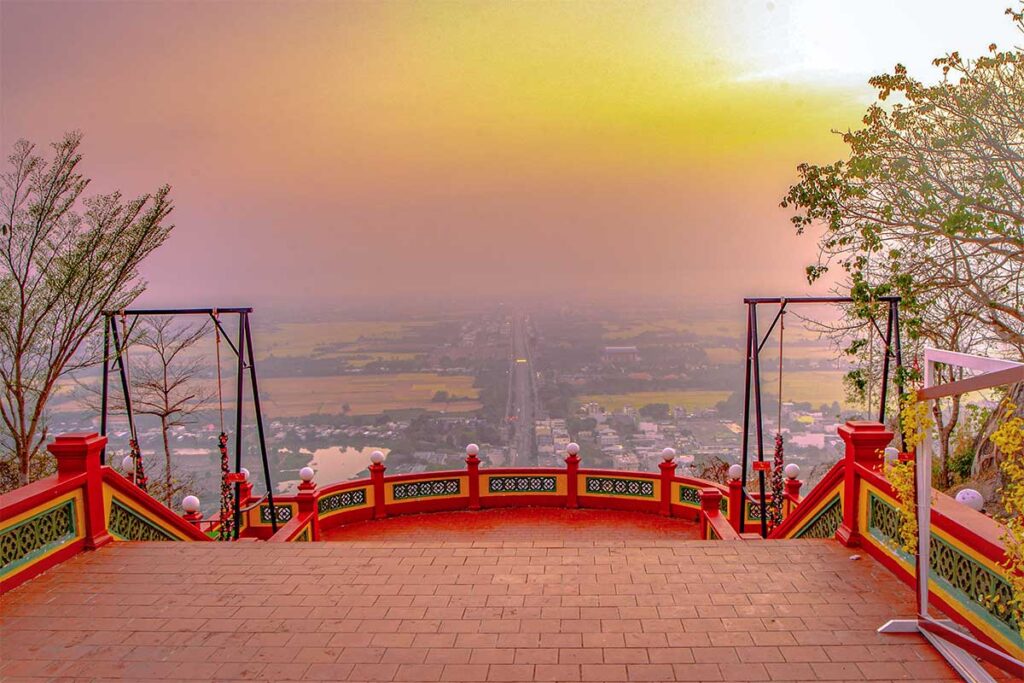
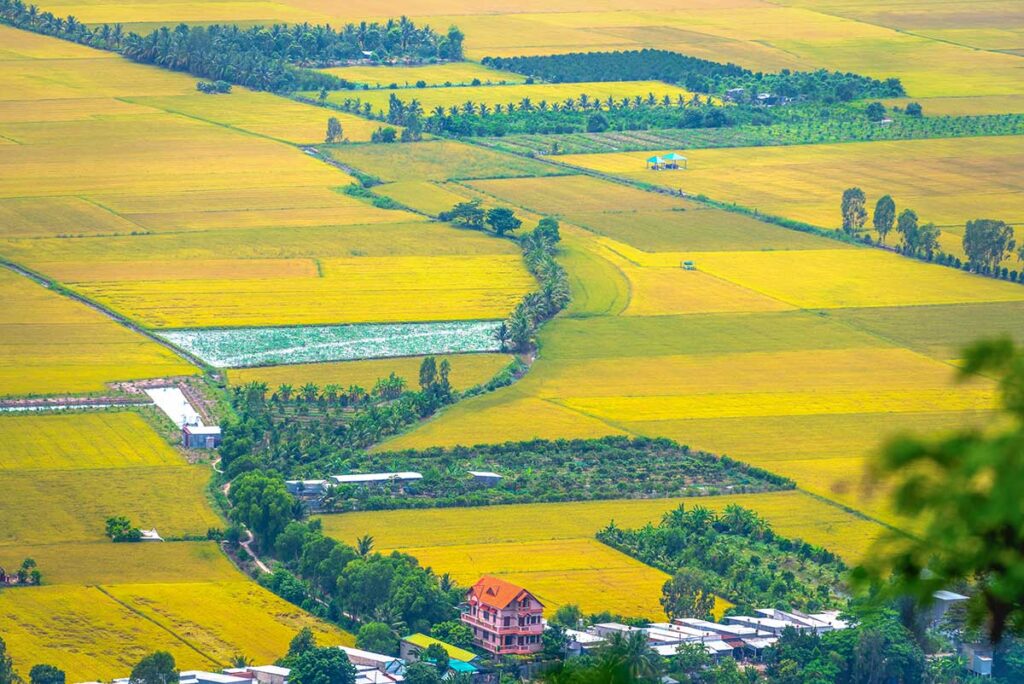
At the top, the reward is the view: endless rice fields stretching across An Giang Province and, on clear days, into Cambodia. The summit area has a small amusement park feel, with snack stalls, cafés, and even the remains of a fairground. A military outpost still operates here, so it’s wise to ask before taking photos in that direction. The facilities themselves are nothing special, but the panorama is the reason most travelers come, and it’s the best vantage point you’ll find in the Mekong Delta.
How to get to Sam Mountain
Getting to Chau Doc
The starting point for visiting Sam Mountain is Chau Doc, a riverside town in An Giang Province. From Ho Chi Minh City, the most common option is a long-distance bus, which takes about 6–7 hours. Buses also run from Can Tho (around 3 hours), making it possible to include Chau Doc in a broader Mekong Delta trip. For more comfort and flexibility, a private car transfer is available, though it’s considerably more expensive than the bus.
From Chau Doc to Sam Mountain
Sam Mountain lies about 6 kilometers outside Chau Doc. The easiest way to get there is by taxi or motorbike. Hotels and homestays in town often arrange motorbike rentals, which give you the freedom to explore the surrounding countryside. Local motorbike taxis can also take you directly up the mountain if you don’t want to walk or use the cable car.
Bicycles are an option for the ride from Chau Doc to the mountain base, since the road is flat, but cycling all the way to the summit is not practical because of the steep climb. For most travelers, it’s best to reach the base by taxi or motorbike, then choose between walking, riding, or taking the cable car to the top.
Practical visiting information & Tips
Entrance fee & Opening hours
There is no entrance fee for Sam Mountain itself or for most of the temples. The main cost is the cable car, which is 150,000 VND per person and usually includes a simple meal at the base restaurant. The cable car operates daily from roughly 7:00 AM to 5:00 PM. If you’re walking or taking a motorbike, you can go up earlier or later, but most temples close around sunset.
Dress code & Etiquette
Sam Mountain is first and foremost a pilgrimage site, so dress modestly. Cover your shoulders and knees, or bring a scarf or sarong to wrap around if needed. Shoes must be removed before entering temple interiors. Photography is generally allowed, but avoid using flash in shrines and be discreet when worshippers are present.
Best time to visit
The most pleasant times are early morning or late afternoon, when the air is cooler and the light is better for views and photos. Midday heat can make the climb exhausting. If possible, avoid weekends, public holidays, and especially the Ba Chua Xu Festival (April/May), when the area becomes extremely crowded with pilgrims.
What to bring
Bring water, as it can be a long and hot climb if you choose to walk. Snacks are handy, though you’ll find plenty of vendors near the base and at the summit. Sunscreen, a hat, and sunglasses are essential under the delta sun. A lightweight scarf or sarong makes it easy to cover up for temple visits.
How much time you need
If you just want to ride the cable car, take in the view, and visit the main temples at the base, 2–3 hours is enough. To explore at a slower pace, stop at pagodas on the slope, or combine walking with the cable car, set aside at least half a day.
Where to stay
Chau Doc Town
Most travelers choose to stay in Chau Doc itself, which is only a short ride from Sam Mountain. The town has a good range of hotels and guesthouses, from budget to mid-range, and puts you close to the markets, boat tours on the river, and the Cham villages nearby. It’s the most practical base if you’re combining Sam Mountain with other sights in the area.
Around Sam Mountain
At the foot of the mountain and in the surrounding countryside you’ll find a handful of basic guesthouses and homestays. These aren’t luxury stays, but they give you a more rural Mekong Delta experience, often with family-style meals and quiet surroundings. If you don’t mind simple facilities, it can be a nice way to experience daily life outside Chau Doc.
Victoria Nui Sam Lodge
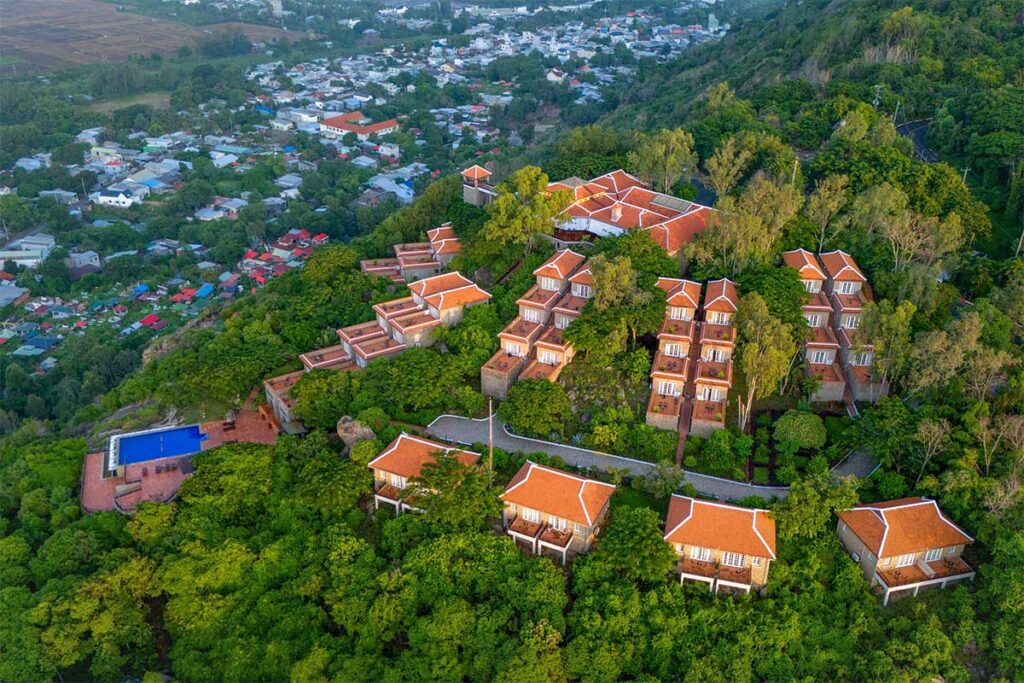
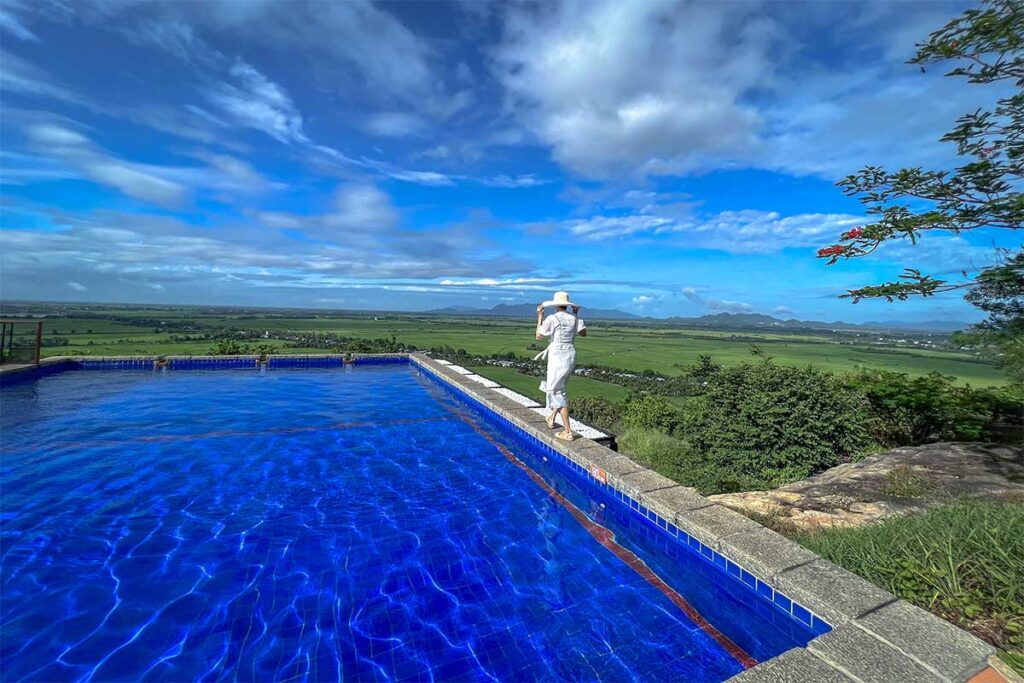
For something more special, the Victoria Nui Sam Lodge is built right on the mountainside. The lodge has bungalows with private terraces overlooking vast rice fields, plus an infinity pool with some of the best views in the Mekong Delta. There’s also a restaurant serving both Vietnamese and Western dishes. It’s popular with couples and travelers who want a quieter, more scenic base than Chau Doc town. While prices are higher than elsewhere in the region, many guests consider the views and peaceful atmosphere well worth it.
What else to do in the area
A visit to Sam Mountain is usually combined with other sights around Chau Doc and An Giang Province, since the mountain itself doesn’t take a full day. Some of the most popular options include:
- Chau Doc floating villages & markets – Wooden houses on stilts line the river, and some families still farm fish in cages beneath their homes. The town’s markets are lively and give a good taste of delta life.
- Cham villages – Just across the river, these traditional villages are home to Vietnam’s Cham minority, with mosques, stilt houses, and weaving traditions to explore.
- Tra Su Cajuput Forest (≈20 km) – A beautiful flooded forest where you can take boat rides through cajuput trees and look for birdlife. It’s one of the most scenic spots in An Giang.
- Ta Pa rice fields (≈1 hour) – Famous for their patchwork of bright green rice paddies framed by palm trees, especially photogenic in the growing season.
For more ideas, see our dedicated guides to Chau Doc and An Giang Province, which cover even more cultural sites, nature spots, and local experiences.
Is Sam Mountain worth visiting?
If you’re already planning to visit Chau Doc or An Giang Province, then yes — Sam Mountain is worth your time. The combination of important temples at the base, smaller pagodas on the slopes, and wide-open views from the top makes it a memorable stop.
That said, it’s not a destination to build an entire Mekong Delta trip around. On its own, the mountain would feel underwhelming, but as part of a broader itinerary that includes places like Tra Su Cajuput Forest, the floating villages, or the rice fields of Ta Pa, it fits in well.
Sam Mountain is best suited to cultural travelers interested in local traditions. If you go with realistic expectations, you’ll likely find it rewarding, especially when combined with other sights in the area.
